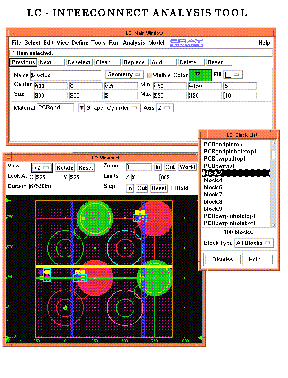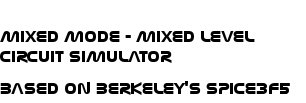Interfacing ngspice with Cray LC

LC is (as stated on the web site) a tool for the analysis of eletromagnetics properties of electrical interconnects. It is a program that uses the FD-TD (Finite Difference - Time Domain) developed by Cray Research with the contribution of other institutions.
LC allows the user to add arbitrary spice circuits (such as drivers and loads) into the interconnect model. The interconnect performance is calculated using the electromagnetic simulation, while the lumped-element circuits are evaluated by spice. Both simulations are performed in the time domain, and proceed in lock step.
LC can be downloaded from its we site and a binary tarball is available for the following platforms:
- SuSE 8 AMD64 Kernel 2.4 and 2.6
- SuSE 9 IA-32 Kernel 2.6
- Linux/Intel with Motif1 of Motif3
- IRIX 6.5 32 and 64 bit
- Solaris 8
Installing LC
Download the binary package for your platform and the
documentation package common to all platforms. Unpack all files and go into
lc2.10 directory. Read the install.html and follow the
installation instructions.
If you look into the lc2.10/bin directory you will
see a spice binary. This is ngspice rework-15 (in lc2.10 package). Try to run ./spice
and look at the banner. You can stop here if this binary fits your needs. If you
want to use a different version of ngspice read the rest of this page.
Compiling ngspice for LC
LC spawn a (ng)spice process and interacts using the command line. To use correctly ngspice with LC you have to compile it without readline library. This is not a real problem since there will be very little interaction with spice in LC environment.
Examples
In the accompaining documentation package there are some examples you may try to see LC and spice in action:
- link: This is a pair of microstrips, shown end-to-end to simplify the modeling and analysis. The left microstrip is excited with a pulse, and the right microstrip is terminated with a resistor load circuit. The microstrips are coupled via a matching impedance L-C network that is simulated as a SPICE circuit. The terminating load is also a SPICE circuit.
- load: This is a microstrip terminated by a resistor simulated in SPICE. Line probe VOLTAGE(LINE) shows the voltage underneath the microstrip as the simulation progresses.CURRENT(PLANE) shows the surface current density on the ground plane.




